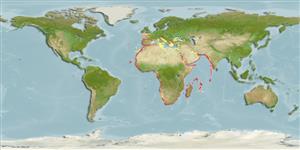>
Eupercaria/misc (Various families in series Eupercaria) >
Sciaenidae (Drums or croakers)
Etymology: Umbrina: Latin, umbra, -ae = shadow, in the sense of phantom; due to its quick movements (Ref. 45335).
More on author: Valenciennes.
Environment: milieu / climate zone / depth range / distribution range
Ökologie
seewasser demersal; tiefenbereich 50 - 300 m (Ref. 4780), usually 150 - 200 m (Ref. 26999). Subtropical; 50°N - 28°S
Eastern Atlantic: Bay of Biscay to South Africa (Ref. 4373), including the western Mediterranean. Western Indian Ocean: east coast of Africa (Ref. 3490); probably also in the Arabian Sea under synonyms capensis (non Pappe ?), sinuata Day and striata Boulenger.
Length at first maturity / Size / Gewicht / Alter
Maturity: Lm 23.5 range ? - ? cm
Max length : 80.0 cm TL Männchen/unbestimmt; (Ref. 30573); common length : 40.0 cm TL Männchen/unbestimmt; (Ref. 3593); max. veröff. Alter: 27 Jahre (Ref. 127644)
Rückenflossenstacheln (insgesamt): 11; Rückenflossenweichstrahlen (insgesamt): 25-29; Afterflossenstacheln 2; Afterflossenweichstrahlen: 7. Juveniles with narrow oblique dark and light stripes, becoming obscure in adults (Ref. 4373).
Found in mud and sandy bottoms of the shelf and upper slope (Ref. 4780), 14° to 15° C (Ref. 36731). Feed on small shrimps, worms and other bottom invertebrates (Ref. 4780). Sold fresh and dried salted (Ref. 3490).
Chao, L.N. and E. Trewavas, 1990. Sciaenidae. p. 813-826. In J.C. Quero, J.C. Hureau, C. Karrer, A. Post and L. Saldanha (eds.) Check-list of the fishes the eastern tropical Atlantic (CLOFETA). JNICT, Lisbon; SEI, Paris; and UNESCO, Paris. Vol. 2. (Ref. 3593)
IUCN Rote Liste Status (Ref. 130435)
Bedrohung für Menschen
Harmless
Nutzung durch Menschen
Fischereien: kommerziell
Mehr Information
ReferenzenAquakulturAquakultur ProfilZuchtlinienGenetikElectrophoresesVererbbarkeitKrankheitenVerarbeitungNutrientsMass conversion
PartnerBilderStamps, Coins Misc.LauteCiguateraGeschwindigkeitSchwimmstilKiemenoberflächeOtolithsGehirngrößeSehfähigkeit
Tools
Zusatzinformationen
Download XML
Internet Quellen
Estimates based on models
Preferred temperature (Ref.
123201): 11.9 - 19.7, mean 15 °C (based on 71 cells).
Phylogenetic diversity index (Ref.
82804): PD
50 = 0.5000 [Uniqueness, from 0.5 = low to 2.0 = high].
Bayesian length-weight: a=0.00851 (0.00551 - 0.01314), b=3.13 (3.00 - 3.26), in cm total length, based on LWR estimates for this species & Genus-body shape (Ref.
93245).
Trophic level (Ref.
69278): 3.4 ±0.44 se; based on food items.
Generation time: 4.2 ( na - na) years. Estimated as median ln(3)/K based on 2
growth studies.
Widerstandsfähigkeit (Ref.
120179): mittel, Verdopplung der Population dauert 1,4 - 4,4 Jahre. (K=0.26).
Prior r = 0.55, 95% CL = 0.36 - 0.82, Based on 2 stock assessments.
Fishing Vulnerability (Ref.
59153): Moderate vulnerability (44 of 100).
Climate Vulnerability (Ref.
125649): Moderate vulnerability (41 of 100).
Nutrients (Ref.
124155): Calcium = 53.3 [29.8, 106.7] mg/100g; Iron = 0.928 [0.470, 1.611] mg/100g; Protein = 19.5 [18.4, 20.6] %; Omega3 = 0.337 [0.202, 0.525] g/100g; Selenium = 41.3 [22.7, 76.7] μg/100g; VitaminA = 8.26 [2.87, 26.43] μg/100g; Zinc = 0.631 [0.450, 0.913] mg/100g (wet weight);
